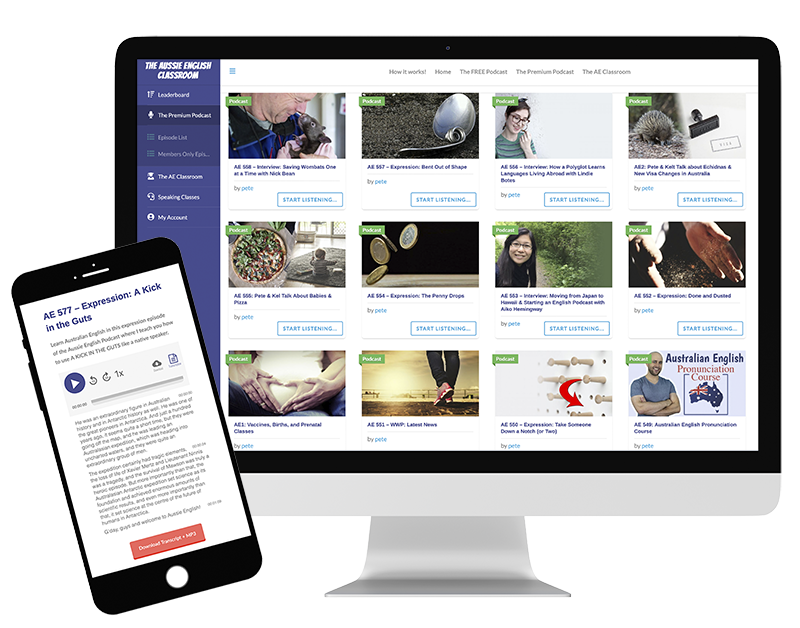To Borrow vs To Lend
Learn Australian English in this episode of Aussie English where Kelly asks me to explain the difference between TO BORROW vs TO LEND.
To Borrow vs To lend
Hi, my name is Kelly, and I’m from Columbia.
I’d like to know the difference between borrow and lend, it’s always a trouble for me, thanks.
Hi Kelly, thank you so much for your question, thank you so much for leaving me a voicemail via the website.
As a result of featuring this episode today where I’m going to be comparing to borrow versus to lend, for Kelly, I want to give a month’s free access to The Aussie English Supporter Pack, so I’ll be getting in contact with you to give you free access for a month to that.
If anyone else is interested in getting free access to The Aussie English Supporter Pack for the first month, then jump onto the website and click the little purple button on the right hand side that says, “Leave me a voicemail”, and leave me a voicemail that I can feature on one of these episodes.
So you can ask me a question about English, about, say, comparing two verbs like to borrow and to lend as Kelly did just now.
Or you could also ask me anything about Australia or about me, anything that you think would be an interesting subject for one of these episodes.
Anyway, let’s dive into today’s episode.
So Kelly, to borrow and to lend, what is the difference?
And you’re not alone, this is the kind of verb that gets confused, even by natives sometimes, especially I guess, younger kids learning to use the stuff but I definitely hear it all the time, you’re not alone, this is made by, this mistake is made by a lot of different people.
So you lend something to someone or you lend someone something, whereas you borrow something from someone.
So it’s the same kind of idea, it’s just that directionality from someone or to someone is kind of inferred depending on which one of these verbs you decide to use.
So to lend, to lend is to give something to someone, for a short period of time, expecting that you’ll get it back.
So if I was to give you one of my CDs and I want it back later, that’s me lending the CD to you.
If I gave you some money and I expected you to pay me back, that’s me lending you some money and then hopefully getting that money back.
If you borrow something now, in the same scenario where you imagine the CD and money, you are the one who is borrowing the CD from me.
You are the one who is borrowing the money from me.
So to borrow means to get something from someone when you’re intending to give it back after a short period of time.
So when it comes to that CD or that money and you and me, if someone is talking about what I’m doing, the action that I’m doing by giving you the CD, by giving you the money, that’s me lending the CD to you, that’s me lending the money to you.
Whereas if someone is referring to what you’re doing in that exchange, then you’re borrowing the CD, you’re borrowing the money.
So hopefully you see what I mean there with regards to directionality, so if someone is talking about you as the person receiving the stuff, you’re borrowing it, and if someone’s talking about me as I’m giving the stuff, then I’m lending it.
So we’ll go through a few more examples just to try and give a bit more context as to how you would use borrow and lend.
And I might also add just quickly before we do that, that to lend is an irregular verb, so to lend becomes lent, in the past simple.
I lent something.
I lent it to him.
Whereas, borrow is a regular verb and in the past simple it’s just borrowed.
I borrowed it from him.
Anyway, let’s get into the examples.
1.
So imagine that you get money from a bank, you get a loan and the money from the bank you want to use in order to buy a car, in order to buy a house, then there’s an assumption there that when you get this money that you’re going to give it back to the bank.
You’re going to give it back to the bank in small payments over time, but the assumption is that eventually you’re going to have to pay back all of the money that you borrowed with obviously interest on top of the amount that you borrow.
So you’re borrowing the money from the bank, you borrow the money. You borrow the money from the bank.
Whereas if we talk about what the bank is doing here, the bank is lending you money, the bank is lending the money to you.
So you’re borrowing it, the bank is lending it.
2.
Example number two, imagine that you want to go on a weekend road trip down the coast, but you don’t have a car, or your car is out of commission, it’s broken.
It’s currently being repaired at the mechanic’s, you know, there’s a servo down the road where there’s a mechanic next to it, you’ve left the car there to get repaired, whatever the case may be, you don’t have a car, but you want to go on this road trip.
So you ask if you can borrow your parent’s car.
So you ask your parents, “Hey guys, can I borrow your car, can I take your car on this road trip with the intention of bringing the car back and giving it back to you? Can I borrow the car for the weekend; can I borrow the car, from you, for the weekend?“
And if we talk about what the parents are doing, the parents could say, “Yes, we will lend you the car for the weekend, we will lend the car, to you, for the weekend.“
So I’m borrowing the car from my parents, my parents are lending the car to me.
3.
A third example could be that two girls want to go out clubbing or partying, so they want to out with their friends in the city, they want to dress up in dresses, in really nice clothes, put make-up on, they want to have a few drinks and go dancing.
So one of them accidentally spills a drink on her friend’s top while they’re getting ready at home, in the house, and the other girl offers to lend her a different top for the night because obviously she doesn’t want go out with a stained top.
So the girl who is giving her spare top, her top that she has as a second top, she’s not using it herself so it’s a spare top, she is lending that top to her friend.
So, “I’ll lend my spare top, I’ll lend my spare top to you.”
And the other friend could say, “Ah, thank you so much for letting me borrow your spare top, I’m going to borrow your top for the night, I’m going to use it and then I’ll bring it home, I’ll probably clean it at my house, I’ll make sure that it’s nice and clean and then give it back to you tomorrow. Thank you for lending your shirt to borrow. Thank for allowing me to use it and then return it to you.“
So hopefully that helps, Kelly.
I know it’s a bit of a confusing one but just go over it a few times and try and remember that it’s directionality.
If it’s you taking something from someone with the intention to give it back to that person, you are borrowing something.
If you want to talk about what that person is doing by giving you something, in the assumption that they’re going to get it back, that person is lending you something.
So let’s practice a substitution exercise here guys, we’ll use the past simple tense for both of these verbs so we can practice the irregular lent, for, to lend, in the past simple.
And we can practice the regular borrowed in the past simple of the verb, to borrow.
So listen and repeat after me guys.
Listen and repeat:
I borrowed his car
He lent me his car.
You borrowed his car
He lent you his car.
He borrowed her car
She lent him her car.
She borrowed his car
He lent her his car.
We borrowed his car
He lent us his car.
They borrowed his car
He lent them his car.
So that’s it for this episode guys.
Thanks again Kelly for leaving me this voicemail and I really hope that you enjoy The Aussie English Supporter Pack.
For anyone else out there who is too impatient to leave me a message, who doesn’t want to leave me a message or maybe doesn’t have anything to ask me in a message, but who wants to sign up for The Aussie English Supporter Pack you can do that, you can go over to the website at www.theaussieenglishpodcast.com and you can sign up for The Aussie English Supporter Pack and get instant access to all the lessons that I’ve done for all of the more recent episodes.
And as a reminder of what’s in The Aussie English Supporter Pack, firstly there are a whole bunch of exercises for each of the more recent episodes; I think we’re passed 12 episodes now that I have created these exercises for, in The Aussie English Supporter Pack.
So you get a vocabulary list for each episode that I do where I go over different vocab used in the lesson.
I create a table for you guys to fill out with definitions of words and synonyms.
I give you language learning tips and advice.
So different websites that you can use that are free in order to practise things like writing, speaking, reading, all of those kinds of things.
I also give you written substitution exercises as well as audio files for those exercises so that you can do them orally.
You can sit there and listen and repeat, treat them as more complicated substitution exercises.
And we also have a Facebook group that is slowly growing.
This group is a private members group so you get access to this group when you sign up, and at the moment I’m trying to come up with activities to do each week where we help each other, bring each other’s English to the next level.
So we all work together and for those people who really want to improve their English rapidly, I really suggest signing up to The Aussie English Supporter Pack and jumping into this group and making the most of it.
Anyway, thanks for listening guys.
Thanks Kelly for your question.
I hope you enjoyed it.
I hope it answered it.
And, I’ll see you in the next episode.
See you guys!
Here's what you get when you sign up!
- Read while you listen using the Premium Podcast player.
- Understand every word in every episode.
- Download all PDF transcripts and MP3s for 600+ episodes.
- Get access to bonus member-only episodes.












Responses